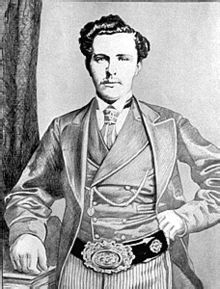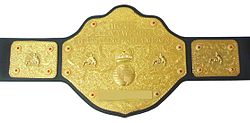- Championship belt
-
 Juan Manuel López with the WBO Latino Super Bantamweight championship belt
Juan Manuel López with the WBO Latino Super Bantamweight championship belt
A championship belt is a large, extravagantly designed belt used primarily in combat sports such as boxing, mixed martial arts and professional wrestling to signify the champions of the promotion or company, much like a cup or trophy in other sports. There are several companies in the business of constructing championship belts.
Contents
Boxing
In boxing, the individual organizations such as the World Boxing Council, The World Boxing Association, the International Boxing Federation and the World Boxing Organization each have their own unique championship belt that are awarded to the champions of each weight class. Boxers, especially the World Champions, strive to win the belt of all 4 organizations to unify their weight divisions. The Ring also created a championship system that is "intended to reward fighters who, by satisfying rigid criteria, can justify a claim as the true and only world champion in a given weight class."
Champions maintain permanent possession of these belts even upon losing their title, with a new belt made when a new champion is crowned.
Weight divisions
There are numerous Boxing weight classes within the sport, with there being minor discrepancies amongst the different governing bodies. The weight classes are:
Weight WBA WBC IBF WBO The Ring BoxRec Over 200 lb Heavyweight Heavyweight Heavyweight Heavyweight Heavyweight Heavyweight 200 lb (90.7 kg) Cruiserweight Cruiserweight Cruiserweight Junior heavyweight Cruiserweight Cruiserweight 175 lb (79.4 kg) Light heavyweight Light heavyweight Light heavyweight Light heavyweight Light heavyweight Light heavyweight 168 lb (76.2 kg) Super middleweight Super middleweight Super middleweight Super middleweight Super middleweight Super middleweight 160 lb (72.6 kg) Middleweight Middleweight Middleweight Middleweight Middleweight Middleweight 154 lb (69.9 kg) Super welterweight Super welterweight Junior middleweight Junior middleweight Junior middleweight Light middleweight 147 lb (66.7 kg) Welterweight Welterweight Welterweight Welterweight Welterweight Welterweight 140 lb (63.5 kg) Super lightweight Super lightweight Junior welterweight Junior welterweight Junior welterweight Light welterweight 135 lb (61.2 kg) Lightweight Lightweight Lightweight Lightweight Lightweight Lightweight 130 lb (59.0 kg) Super featherweight Super featherweight Junior lightweight Junior lightweight Junior lightweight Super featherweight 126 lb (57.2 kg) Featherweight Featherweight Featherweight Featherweight Featherweight Featherweight 122 lb (55.3 kg) Super bantamweight Super bantamweight Junior featherweight Junior featherweight Junior featherweight Super bantamweight 118 lb (53.5 kg) Bantamweight Bantamweight Bantamweight Bantamweight Bantamweight Bantamweight 115 lb (52.2 kg) Super flyweight Super flyweight Junior bantamweight Junior bantamweight Junior bantamweight Super flyweight 112 lb (50.8 kg) Flyweight Flyweight Flyweight Flyweight Flyweight Flyweight 108 lb (49.0 kg) Light flyweight Light flyweight Junior flyweight Junior flyweight Junior flyweight Light flyweight 105 lb (47.6 kg) Minimumweight Strawweight Mini flyweight Mini flyweight Strawweight Minimumweight Professional wrestling
Main article: Championship (professional wrestling)Professional wrestling is a form of entertainment which combines athletics and theatrical performance in a mimicry of combat sports. Many storylines center around the promotion's championships, which are represented by championship belts similar to those in boxing. The top title in a major promotion is usually designated a World heavyweight championship Other, lesser championships may carry regional names, be limited to a specific weight class, or be defended in other special circumstances, such as the traditional tag team match.
The WWE is the largest promotion in pro wrestling. As a result of the company's history if acquisitions, WWE boasts two top titles, each assigned to one of the company's "brands". As of September 2011, the WWE Championship is designated to the Raw brand, while the World Heavyweight Championship is designated to the SmackDown brand.
Typically, pro wrestling title belts have a unique design for each title, in contrast with boxing where the title belts of a given sanctioning body are all the same design. The most notable exception is Japan's Pro Wrestling Noah, whose belts follow one specific design.
Mixed martial arts
At the time of the UFC's inception in 1993, the sport of mixed martial arts was unsanctioned in the United States, and as such weight classes did not exist; instead of the traditional championship model, tournaments were held with the winner receiving a permanent appellation.[1] In response to criticism from Senator John McCain which saw the loss of their television deal and the banning of the sport in thirty-six states, the UFC increased its cooperation with state athletic commissions and introduced weight classes in 1997.[2]
The original codification for weight classes introduced only two divisions—heavyweight; which grouped competitors above 200 lb (91 kg), and lightweight; which encompassed all other competitors. The UFC would later rename their lightweight division to middleweight, and add lightweight (170 lb, 77 kg) and bantamweight (155 lb, 70 kg) divisions. In 2000, the New Jersey State Athletic Control Board completely took over regulation in its home state, and their rules and weight classes became the de facto rule set for mixed martial arts today.[3] The UFC realigned their weight classes to comply with the new regulations in 2001.[4]
Motorsports
The Las Vegas Motor Speedway offers a championship belt in lieu of the traditional trophy for drivers who win the Shelby 427 NASCAR Sprint Cup race there, owing to the traditional site of Las Vegas as the fight capital of the world.
Other sports
 Tom Morris, Jr. wearing the Championship Belt.
Tom Morris, Jr. wearing the Championship Belt.
Historically, the championship belt was also awarded to the winner of professional golf tournaments. Rodeo tournaments also award special belts, among other prizes.
More recently, starting with Aaron Rodgers, the "title belt" gesture has begun the leap to the major professional sports. Originally used by Rodgers during his time on the Green Bay Packers practice squad as a way to keep his teammates loose, it became known more as the Packers 2010 season progressed, eventually culminating with a victory. On the podium to receive the Vince Lombardi trophy, Rodgers was presented with a replica Big Gold Belt by teammates, and in the following weeks, during a scheduled WWE Raw telecast, the Packers were honored with title belts from the WWE itself. In September 2011, after the Milwaukee Brewers clinched the National League Central title, Kameron Loe was seen sporting a replica WWE Championship "spinner" belt.
References
- ^ Plotz, David (1999-11-07). "Fight Clubbed". Slate. http://www.slate.com/id/46344. Retrieved 2007-03-21.
- ^ Gentry III, Clyde (2003). No Holds Barred: Ultimate Fighting and the Martial Arts Revolution (Paperback Edition ed.). Milo Books. pp. 106, 123. ISBN 0-903854-90-X.
- ^ "Mixed Martial Arts Unified Rules of Conduct". New Jersey State Athletic Control Board. 2000. http://www.state.nj.us/lps/sacb/docs/martial.html. Retrieved 2007-09-08.
- ^ Trembow, Ivan (2000). "New Jersey Commission Corrects Mainstream UFC Stories" (Reprint). MMA Weekly. http://www.ivansblog.com/2006/07/mixed-martial-arts-new-jersey.html. Retrieved 2007-09-08.
External links
- Official Website of All Star Championship Belt makers
- Official Website of Wildcat Championship Belts
- Official Website of Masis Boxing Belts
- Official Website of Reggie Parks' Championship Belts
- Official Website of Dave Millican Belts
- Official Website of Championcraft
- Official Website of J-Mar Belts
- Official Website of Top Rope Belts
- Official Website of Beltmaker Christian Löns
- Wrestling Beltworld
Categories:- Boxing awards
Wikimedia Foundation. 2010.







